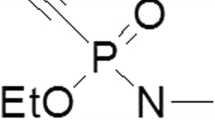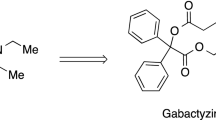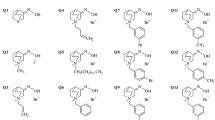Abstract
HI 6 has been shown to be efficacious in soman intoxication of laboratory animals by reactivation of acetylcholinesterase. To assess possible risks involved in the administration of HI 6 its degradation products were analyzed at pH 2.0, 4.0, 7.4, and 9.0.
At pH 2.0, where HI 6 in aqueous solution has its maximal stability, attack on the aminal-acetal bond of the “ether bridge” predominates, with formation of formaldehyde, isonicotinamide, and pyridine-2-aldoxime. Besides, HI 6 decomposes at the oxime group yielding 2-cyanopyridine. Liberation of hydrocyanic acid at pH 2.0 is below 5%.
At pH 7.4, primary attack is on the oxime group, resulting in formation of the corresponding pyridone via an intermediate nitrile. The pyridone has been isolated and identified as 2-pyridinone, 1-(((4-carbamoylpyridinio)methoxy)methyl)formate. This major metabolite deaminates further to the 2-pyridinone, 1-(((4-carboxypyridinio)methoxy)methyl) derivative, which ultimately decomposes into formaldehyde, isonicotinic acid, and 2-pyridone. Hydrolysis of the acid amide group probably also occurs with HI 6 itself. Significant amounts of free hydrocyanic acid were only detected in the presence of an alkali trap; otherwise hydrocyanic acid reacts with formaldehyde to yield hydroxyacetonitrile from which hydrocyanic acid can be liberated again. Up to 0.6 equivalents of hydrocyanic acid were evolved at pH 7.4.
After repetitive administration and impaired renal elimination of HI 6, e.g. during renal shock, there might be some risk of cyanide intoxication.
Similar content being viewed by others
References
Askew BM, Davies DR, Green AL, Holmes R (1956) The nature of the toxicity of 2-oxo-oximes. Br J Pharmacol 11: 424–427
Bošković B (1981) The treatment of soman poisoning and its perspectives. Fund Appl Toxicol 1: 203–213
Bošković B, Kovačević V, Jovanović D (1984) PAM-2 Cl, HI-6, and HGG-12 in soman and tabun poisoning. Fund Appl Toxicol 4: S106-S115
Brown ND, Stermer-Cox MG, Doctor BP, Hagedorn I (1984a) Separation of HI 6 and its degradation products by ion-pair high-performance liquid chromatography. J Chromatogr 292: 444–450
Brown ND, Gray RR, Stermer-Cox MG, Doctor BP, Hagedorn I (1984b) Stability study of HI 6 —dichloride in various anticholinergic formulations. J Chromatogr 315: 389–394
Christenson I (1968a) Hydrolysis of bis(4-hydroxyiminomethyl-1-pyridiniomethyl)ether dichloride (Toxogonin). Acta Pharm Suec 5: 23–36
Christenson I (1968b) Hydrolysis of bis(4-hydroxyiminomethyl-1-pyridiniomethyl)ether dichloride (Toxogonin). II. Kinetics and equilibrium in acidic solution. Acta Pharm Suec 5: 249–262
Christenson I (1972) Hydrolysis of obidoxime chloride (Toxogonin). III. Kinetics in neutral and alkaline solution. Acta Pharm Suec 9: 309–322
Clement JG (1982) HI-6: Reactivation of central and peripheral acetylcholinesterase following inhibition by soman, sarin and tabun in vivo in the rat. Biochem Pharmacol 31: 1283–1287
Ellin RI (1958) Stability of pyridine-2-aldoxime methiodide. 1. Mechanism of breakdown in aqueous alkaline solution. J Am Chem Soc 80: 6588–6590
Ellin RI, Carlese JS, Kondritzer AA (1962) Stability of pyridine-2-aldoxime methiodide. II. Kinetics of deterioration in dilute aqueous solutions. J Pharm Sci 51: 141–146
Enander I, Sundwall A, Sörbo B (1961) Metabolic studies on N-methylpyridinium-2-aldoxime. I. The conversion to thiocyanate. Biochem Pharmacol 7: 226–231
Eyer P, Hell W (1985) Chemical stability of the Hagedorn oximes HGG-12 and HI 6. Arch Pharm 318: 938–946
Eyer P, Hell W (1986) Untersuchung des Zerfalls von HGG 12 in wäßriger Lösung. Arch Pharm 319: 558–566
Gross G (1980) Entwicklung von hochwirksamen Gegenmitteln bei Vergiftungen mit toxischen Phosphonsäureestern. Inaugural Dissertation, Freiburg
Hagedorn I, Gündel WH, Schoene K (1969) Reaktivierung phosphorylierter Acetylcholin-Esterase mit Oximen: Beitrag zum Studium des Reaktionsablaufes. Arzneimittelforsch 19: 603–606
Hagedorn I, Stark I, Lorenz HP (1972) Reaktivierung phosphorylierter Acetylcholin-Esterase. Abhängigkeit von der Aktivator-Acidität. Angew Chem 84: 354–356
Klimmek R, Szinicz L, Weger N (1983) Chemische Gifte und Kampfstoffe. Wirkung und Therapie. Hippokrates Verlag, Stuttgart
Kosower EM, Bauer SW (1960) Pyridinium complexes. II. The nature of the intermediate in the dithionite reduction of diphosphopyridine nucleotide. J Am Chem Soc 82: 2191–2194
Kušić R, Bošković B, Vojvodić, Javanović D (1985) HI-6 in man: Blood levels, urinary excretion, and tolerance after intramuscular administration of the oxime to healthy volunteers. Fund Appl Toxicol 5: S89-S97
Ligtenstein DA (1984) The synergism of HI 6 and atropine in organophosphate intoxications. Thesis, Leiden/Netherlands
Marcov V, Rakin D, Binenfeld Z (1984) Hidroliza 1-(2-hidroksiiminometil-1-piridinijum)-3-(4-karbamoil-1-piridinijum)-2-oksapropan dihlorida (HI 6). Ispitivanje, stabilnosti vodenih rastvora. Naučno-technički pregled 34: 19–24
Philipović I, Vukušić I (1983) Stability of oxime HI 6 in acidic solutions. Abstracts of the Second International Meeting on Cholinesterases, Bled
Simons KJ, Briggs CJ (1983) The pharmacokinetics of HI 6 in beagle dogs. Biopharm Drug Dispos 4: 375–388
Sket D, Brzin M (1986) Effect of HI 6, applied into the cerebral ventricles, on the inhibition of brain acetylcholinesterase by soman in rats. Neuropharmacology 25: 103–107
Sterri SH, Lyngaas S, Fonnum F (1983) Cholinesterase and carboxylesterase activities in soman poisoned rats treated with bispyridinium mono-oximes HI-6 and HS-6. Biochem Pharmacol 32: 1646–1649
Williams WJ (1979) Handbook of anion determination. Butterworth Co Ltd. London, p 70
Author information
Authors and Affiliations
Rights and permissions
About this article
Cite this article
Eyer, P., Hell, W., Kawan, A. et al. Studies on the decomposition of the oxime HI 6 in aqueous solution. Arch Toxicol 59, 266–271 (1986). https://doi.org/10.1007/BF00290549
Received:
Accepted:
Issue Date:
DOI: https://doi.org/10.1007/BF00290549




